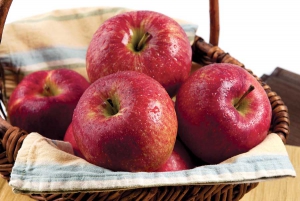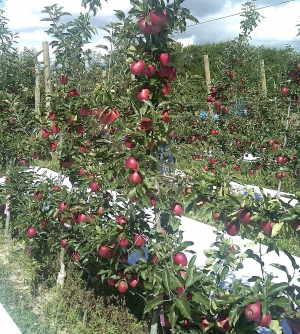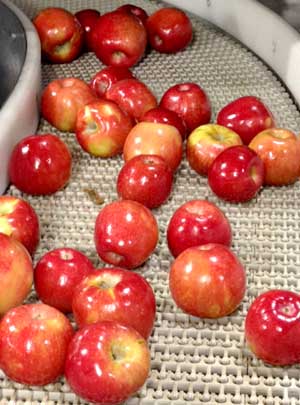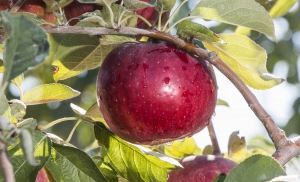A number of new varieties that are coming to market are being touted as being better than Honeycrisp.
Pazazz

Pazazz (Courtesy Honeybear Brands)
Pazazz, a variety developed by Doug Shelfelbine in his private breeding program in Wisconsin, originated from an open-pollinated Honeycrisp, according to Fred Wescott, who is commercializing the variety.
The striped red apple was selected from 50,000 to 60,000 seedlings in the program because of its exceptional eating quality, Wescott said. “It has a wonderful texture and flavor, and it has more sugar and more acid than Honeycrisp.”
Probably its greatest characteristics are its flavor profile and its texture, and its ability to maintain flavor late into the season.
“I’ve got some still sitting in the refrigerator from last October’s harvest that still have crunch and good eating quality,” he said when interviewed in late April.
The name Pazazz was chosen because that’s the word that comes to mind when people taste it, Wescott said. “This apple’s got real pizazz.”
The variety has been planted in major growing regions in North America from Washington to Nova Scotia and is being tested in the Southern Hemisphere. Honeybear Brands of Minnesota, the exclusive marketer, expects to sell perhaps 30,000 to 50,000 cases this year.
Wescott said hundreds of acres of the variety have been planted and production should ramp up quickly in future years.
Breeze

Breeze, a New Zealand apple, is being planted in Washington State for the global market.
(Courtesy Sage Fruit Company)
Sage Fruit Company in Yakima, Washington, is the exclusive marketer in the United States for a variety called Breeze, which originated in New Zealand. It is a chance seedling discovered about 15 years ago by growers in the Nelson area of the South Island.
Because it was found in an old Gala block, it could be a descendant of Gala, though it has distinct differences, said Steve Reisenauer, sales manager at Sage. The apple has a solid pink-red blush and is sweeter and firmer than Gala, with a whiter flesh.
“But what we liked about it was its storability,” he said, noting that even fruit from young trees has come out of nine months of controlled-atmosphere storage in great condition.
Sage is partnering with Fresh Fruit Company of New Zealand on a year-round marketing strategy for Breeze and has joint marketing agreements in North America and internationally, Reisenauer said. The variety is expected to appeal to Asian consumers because of its flavor, sweetness, and appearance.
Sage has been marketing a limited quantity of Breeze apples from New Zealand, where growers have a three- to four-year jump on the variety. It is now being planted in Washington, and Reisenauer said he hopes it will be in commercial production by 2017 or 2018.
CN 121

CN121
Chelan Fruit Cooperative of Chelan, Washington, and Gebbers Farms of Brewster, Washington, have an exclusive, still unnamed variety that they believe is an improvement on Honeycrisp. Tom Riggan at Chelan Fresh, which is the exclusive marketer, said CN 121, as it is known, received very positive feedback from retailers at trade shows.
“They’re always looking for something new,” he said. “This is unique. It does have the wow factor. We’ve had very positive feedback from our customers that, yes indeed, they want them.”
Riggan said the apple is sweeter and redder than Honeycrisp. “We’re very excited. It’s a tremendous apple. We’ve tested it for a number of years and it’s been very consistent.”
Harold Schell, field horticulturist with Chelan Fruit, said CN 121 originated from an open-pollinated Honeycrisp and is an improvement on Honeycrisp in several ways.
“It still has some of its mother’s characteristics,” he said. “It’s a very firm apple and it holds its firmness extremely well in storage, and it’s a very sweet apple.”
The tree grows similar to Honeycrisp and will runt out if cropped too early, he said, but CN 121 fruits consistently from year to year and has a low propensity to bitter pit. Fruit is in the 70 to 100 size range, peaking on 80s and 88s.
The fruit will be grown exclusively by Chelan Fruit and Gebbers. Schell said growers were planting their first commercial trees this spring. More trees will be planted in 2015, and around 200,000 will be planted by 2016.
“We will probably have some fruit to market by 2020,” he said.
WA 38 (Cosmic Crisp)

A WA 38 apple, now named Cosmic Crisp, grown near Quincy, Wash., on Sept. 18, 2013. (TJ Mullinax/Good Fruit Grower)
Washington State University’s latest variety, WA 38, is also a descendant of Honeycrisp, and is getting great reviews for its flavor and storability. In taste tests, consumers preferred WA 38 to Honeycrisp after the apples had been held in storage for six months (see “Consumers rate WA 38”).
Tom Auvil, research horticulturist at the Washington Tree Fruit Research Commission, said crisp, juicy, and sweet are the passwords needed for apples to get into consumers’ shopping carts.
Apples right out of storage are often excellent, but after a week at room temperature, they might not be that good.
There’s a short list of varieties in commercial production that meet consumers’ expectations and have predictable texture, sweetness and flavor, he said. These include Honeycrisp, Jazz, Opal, Envy, Aurora, Ambrosia, and WA 38. Some are more friendly to grow and pack than others. Some don’t like heat, others don’t like cold, and a few don’t like to be either too cold or too hot. WA 38 has done well in several different environments.
This season, WA 38 apples held until January in regular storage had no bitter pit, no sunburn, and no internal defects, and still had good eating quality without being treated with MCP (1-methylcyclopropene). In contrast, Honeycrisp apples had a high cullage rate. •






Leave A Comment